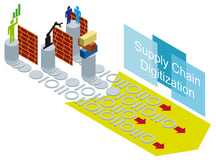How Should Manufacturers Measure Digital Maturity?
Brian Hoey - June 16, 2020

 When you’re considering a new business initiative or a major operational change, how do you decide whether or not you’re ready? For most businesses, it’s not an exact science. Whatever project you’re undertaking, you have to figure out how to get from Point A to Point B, but in many situations this is easier said than done, with hidden steps and pitfalls lurking on the path to successful implementation. With digital technology, effective preparation can be even more difficult. In a study with the MIT Sloan Management Review, Deloitte found that while more than 80% of businesses expect digital technology to disrupt their organizations, fewer than half felt like they were fully prepared.
When you’re considering a new business initiative or a major operational change, how do you decide whether or not you’re ready? For most businesses, it’s not an exact science. Whatever project you’re undertaking, you have to figure out how to get from Point A to Point B, but in many situations this is easier said than done, with hidden steps and pitfalls lurking on the path to successful implementation. With digital technology, effective preparation can be even more difficult. In a study with the MIT Sloan Management Review, Deloitte found that while more than 80% of businesses expect digital technology to disrupt their organizations, fewer than half felt like they were fully prepared.
With the age of Industry 4.0 already beginning to take shape, there’s never been more pressure on manufacturers to drive towards digital maturity and digital transformation. But as we can see from the statistic above, not everyone is moving at the same pace—meaning that different outfits will face different hurdles on the road to creating a smart, digital supply chain. The first hurdle? Figuring out exactly what your level of digital maturity is, such that you can create a roadmap for future innovation and transformation.
What Is Digital Maturity?
At the most basic level, digital maturity refers to your business’ readiness to adopt digital technologies and processes in pursuit of digital transformation. Though there aren’t necessarily a set of agreed upon numeric metrics that show your objective level of readiness, businesses like Deloitte and others do offer models for figuring out where you stand in terms of your ability to create new digital processes that drive growth. These models tend to measure readiness based on a few different factors:
- Strategy/Operations: How are you working to add value and stay competitive? How integrated are digital technologies with the way you think about the future of the business? How much do your current operations rely on digital technology?
- Technology: Are your various processes and workflows integrated through technology? Or do you still use pen and paper for planning workflows?
- Culture: Do planners within your company adapt well to new initiatives? Do teams work to refine and optimize their processes over time, or do production plans, inventory workflows, and other processes remain fairly static?
- Customer Experience: Are your current customers willing to use you as a digital resource? Do they interact with any client-facing tools or apps you may be making available? Does your technology integrate with that of your supply chain partners?
Based on this information, you can get a rough sketch of your readiness levels for digital transformation. Why is it important to measure something like your level of readiness? Simply put, these measurements can help you to identify gaps in your progress and uncover areas for improvement. In this way, you can begin to take a more systematic approach to digital transformation and Industry 4.0 adoption.
Measuring the Stages of Digital Maturity
Okay, we saw some of the factors by which we model digital maturity above, but how do you actually go about measuring which stage of digital maturity you’re in? At Forbes, they describe a series of four stages of maturity:
- Incidental: At this stage, you may have some digital technology driving your processes, but it’s not part of a larger initiative. Disparate technological solutions (e.g. in sales planning versus production planning) don’t interact in a meaningful way, leading to planning silos.
- Intentional: Though your entire technology ecosystem may not be fully integrated, you have some amount of vision, leadership, and strategy directed towards Industry 4.0 adoption or digitization more broadly. You’re probably still working out the kinks, but you’re on the right track and beginning to see the difference.
- Integrated: At this stage, you actually have technology integration across touchpoints and throughout the entire supply chain. Maybe you’re able to leverage more advanced analytics to refine existing processes and create new ones. Here, there might be some unevenness from one function to another, but the company as whole is committed to digital transformation.
- Optimized: Of course, there is no point at which your business is “finished” transforming—but it is possible to reach a stage where your digitization is so thorough that pivoting to new technologies and re-adapting in a responsive way to changes in the market is second nature. By this point, you’re more than Industry 4.0-ready.
In order to create a “scorecard” of sorts for your digital maturity, you can rank each of the four areas we discussed in the section above based on the scale we just sketched out. This will give you a clear sense of where you are in the process and where you might have gaps in your overall digitization efforts.
Digital Transformation and Industry 4.0
This all might seem like it’s a lot of work, with the potential for significant headaches and roadblocks along the way—but the payoff for successful digitization is absolutely worth it. If you can use the rubric above to pinpoint areas of improvement in order to drive more effective digital transformation throughout your operations, you can begin to adopt Industry 4.0 technology with the power to completely transform the way you do business. Industry 4.0 deserves more than a blog post’s worth of discussion, but suffice it to say that the cyber-physical systems and AI- and machine learning-driven processes that characterize it can make you more responsive to disruptions and help you optimize your supply chain end-to-end.
Once you have connectivity up and down the value stream—such that you can gather data from your suppliers, analyze that data so your production planners can optimize, and then route your finished through a transport network that’s been digitally simulated to improve performance—you can reduce the costs associated with disruptions, silos, and poor planning. More than that, you can (and should) find new ways to add value for your customers and partners. In this way, you can create a supply chain that’s truly proactive, rather than reactive. All it takes is a little bit of digital maturity.
LATEST POSTS
- Understand Why Production Planning Needs Specialized Solutions
- Understand Circular Economy in The Manufacturing Industry
- How Can Industry 4.0 IT Integration Be Achieved Smoothly?
- The Significance of Order Sequencing in Discrete Manufacturing
- How to improve your Supply Chain Management: The Power of Control Towers



